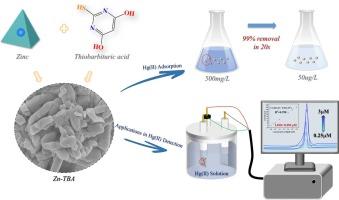Novel Zn-based metal coordination polymer for ultrafast capture and electrochemical sensing of Hg(Ⅱ)
IF 8
1区 化学
Q1 CHEMISTRY, ANALYTICAL
引用次数: 0
Abstract
The electrochemical sensor shows great promise in the detection of trace Hg(Ⅱ), of which the performance could be significantly enhanced by the functionalized material with the merits of effective and ultrafast capture for Hg(Ⅱ). In this study, the novel metal coordination polymers (MCPs) was synthesized by the 2-thio-barbituric acid as the organic ligand to modify the electrochemical sensor to address this issue. The as-prepared material was composed of regular flakes with a polyhedral and well-defined crystal structure, the successful loading of the abundant sulfurous group (7.49 % of the total mass) endowed the Zn-TBA with the capability to efficiently uptake (97.4–99.9 %) Hg(Ⅱ) at 500 mg/L under a wider pHs as well as the high content of coexisting cations and anions, highlighted the excellent capacity, strong environmental adaptability, and selectivity. Notably, the superfast mass transfer was revealed in the adsorption kinetics test, in which the Hg(Ⅱ) content was effectively reduced from 50 mg/L to 14 μg/L within 20 s to meet the national emission standards. Based on this, Zn-TBA modified the carbon cloth (Zn-TBA/CC) and the glass carbon electrode (Zn-TBA/GCE) was prepared, thereinto, the current response of Zn-TBA/CC was approximately 60 times that of the pristine electrode. A strong positive correlation (R2=0.998) relationship could be attained across the content of 0.25–3 μM, achieving the detection limit to be 0.29 μM. The impressive performance was maintained in the complex matrices and regeneration test. In addition, Zn-TBA/CC exhibited better physical properties, charge transfer ability, and sensing properties than Zn-TBA/GCE, highlighting the advantages of CC as a flexible sensor substrate. Finally, the stable recovery (90–98.5 %) in the spiked actual surface water confirmed that the two established methods possessed a promising application potential in capturing and detecting the trace Hg(Ⅱ) with high accuracy and precision. This study extended the application of MCPs in the electrochemical sensor and provided an available analysis method to trap and determine the metal content.

用于超快捕获和电化学传感汞(Ⅱ)的新型锌基金属配位聚合物
电化学传感器在痕量 Hg(Ⅱ)的检测中大有可为,而功能化材料具有有效和超快捕获 Hg(Ⅱ)的优点,可显著提高其性能。针对这一问题,本研究以 2-硫代巴比妥酸为有机配体合成了新型金属配位聚合物(MCPs),用于改性电化学传感器。所制备的材料由规则的薄片组成,具有多面体和清晰的晶体结构,成功负载了丰富的亚硫基团(占总质量的 7.49%),使 Zn-TBA 在较宽的 pH 值和较高的共存阳离子和阴离子含量条件下,能在 500 mg/L 的浓度下高效吸收(97.4-99.9%)Hg(Ⅱ),具有优异的容量、较强的环境适应性和选择性。值得注意的是,在吸附动力学测试中显示了超快的传质速度,在 20 秒内将 Hg(Ⅱ)含量从 50 mg/L 有效降至 14 μg/L,达到了国家排放标准。在此基础上,制备了 Zn-TBA 改性碳布(Zn-TBA/CC)和玻碳电极(Zn-TBA/GCE),Zn-TBA/CC 的电流响应约为原始电极的 60 倍。在 0.25-3 μM 的含量范围内,可以达到很强的正相关关系(R2=0.998),检测限为 0.29 μM。在复杂基质和再生试验中也保持了令人印象深刻的性能。此外,与 Zn-TBA/GCE 相比,Zn-TBA/CC 表现出更好的物理性质、电荷转移能力和传感性能,突出了 CC 作为柔性传感器基底的优势。最后,两种方法在实际地表水中的稳定回收率(90-98.5%)证实了它们在高精度捕获和检测痕量汞(Ⅱ)方面具有广阔的应用前景。这项研究拓展了 MCPs 在电化学传感器中的应用,为捕集和测定金属含量提供了一种可用的分析方法。
本文章由计算机程序翻译,如有差异,请以英文原文为准。
求助全文
约1分钟内获得全文
求助全文
来源期刊

Sensors and Actuators B: Chemical
工程技术-电化学
CiteScore
14.60
自引率
11.90%
发文量
1776
审稿时长
3.2 months
期刊介绍:
Sensors & Actuators, B: Chemical is an international journal focused on the research and development of chemical transducers. It covers chemical sensors and biosensors, chemical actuators, and analytical microsystems. The journal is interdisciplinary, aiming to publish original works showcasing substantial advancements beyond the current state of the art in these fields, with practical applicability to solving meaningful analytical problems. Review articles are accepted by invitation from an Editor of the journal.
 求助内容:
求助内容: 应助结果提醒方式:
应助结果提醒方式:


